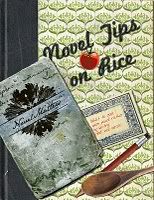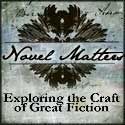We'd like to draw your attention to a new feature to the blog--"search this blog" function has been added to Novel Matters to help you locate archived articles on Novel Matters. Give it a try! And keep coming back to discover new ways to engage in the conversation about writing and the writing life.

This month, the Novel Matters Roundtable is a true roundtable discussion. What follows is a transcript of the six of us in discussion about the topic of dialogue in fiction. We got a bit silly a couple of times, but that is how it goes whenever the six of us get together. We laugh a great deal. We sincerely hope you enjoy this transcript. When we were done, Patti Hill remarked, “It makes me want to have a retreat with all of you.”
Bonnie: Rich discussion this month on Novel Matters—I’ve noticed that dialogue has cropped up a number of times in different posts. Strong dialogue. Believable, driving plot, revealing. A tall order. When you sit down to write (or edit) a scene with lots of dialogue, how do you know your characters are ringing true? There is what is being said, and then there is conveying the manner in which it is being said, and the manner in which other characters perceive it’s being said.
Uh... What was I saying?
Katy: For me it's like being an actress, and getting into character. If I crawl into my character’s skin, take on the past that she has lived and feel what she must be feeling in the moment, then I can open my mouth and the words will come out. The tricky part is to inhabit more than one character at the same time, so I can carry all sides of the conversation. Sometimes I have to type quickly.
Bonnie: In theater that is called method acting. Method writing! I’d love to see you in action, Katy! So, for each character, you write an extensive history? Or how does that work?
Katy: Ha! I shut the door when I write - it looks too crazy. After I’d done my first novel this way, I discovered that Brandilyn Collins had written an excellent book on method writing, titled "Getting Into Character." She suggests writing very extensive histories by interviewing your characters, asking them questions and accepting as normal reality the fact that they answer back. I don't do it quite that way. I start off with just highlights of their past, because I know they will tell me more as the story progresses - and would do so even if it contradicted what I had already scripted for them.
Patti: Uh, is this the roundtable discussion going on? Is this the official start? Still waking up!
Bonnie: It has officially started, yes. Jump in!
Sharon: I don't have to shut the door, because I'm mostly home alone when I write. Which makes talking to myself all the more crazy. But I definitely do work out loud on my dialogue, and rehearse it over and over till I get it right. Because it's hugely important to get it right. When I'm not alone, I do a lot of whispering to myself. The point is, my lips are moving a lot, but it's often not because I'm involved in dialogue with real people, or real people who might happen to be in the same room with me. My family doesn't even question it anymore.
Bonnie: Katy, Love this. Reminds me of Arthur Plotnik’s guest post about Stage Business. The line he wrote that has always stuck with me is: "I love you," he told her. She checked her cell phone. No messages. "Love you, too." Sharon, I read aloud too. Not just dialogue, but especially dialogue. There’s authenticity to test, as you point out. I also listen to the character’s dialogue to ensure it’s unexpected, surprising, and interesting. I want my characters to say what they are saying without saying it in a way a reader would expect it to be said.
Sharon: Exactly, Bonnie. Straightforward dialogue can be extremely boring. I've read a number of manuscripts as contest entries this spring -- and a few books up for awards -- and I find this problem in the dialogue of novice writers all the time. Sub-text is a vital element to good dialogue in fiction.
Patti: Funny how so many of us have method-writing in common. And I agree, you must close the door if other people are in the house. If I don’t, hubby calls up from downstairs, “Did you say something?” Uh, yeah. Uh, no. That little contradiction reminds me of what’s so important in dialogue and deepens characterization. In good dialogue, the characters have opposing goals. One wants to talk about a new treatment for cancer. The other has already decided to forgo treatment but isn’t ready to say so. One wants to learn more about their relationship. The other would rather talk about anything else, so she talks about the high price of tomatoes. One is pleading for help, the other is squirming, changing the subject, interrupting, leaving the room. I’m not talking about arguments, but all of our characters want something, sometimes they want the same thing. They just go after it differently, and this shows up in dialogue.
I love writing dialogue.
Latayne: Recently I went back and looked at what I consider an exemplar for dialogue, The Help. Since it is all first person with multiple POVs, technically it's all dialogue. Stockett does a great job, I think, of creating distinct characters all participating in the same scenario. However, large sections of the book are each character's recounting of "quotation marks" dialogue where each recalls conversations. That's a bigger challenge for a writer, I think, when the narrator is already showing biases and distinct voice, and then conveys conversations.
Debbie: Maybe because I'm a visual learner, I love good movies (and some funny ones that wouldn't win any awards). When I sit down to write a scene, I 'see' it like it would play out in a movie from a script in front of me. I'm usually an onlooker, not a character, though I have to get into their heads. I'm a voyeur? :)
Katy: A voyeur that gets into people's heads. Sounds like a great plot for a movie...
Bonnie: ‘Being John Malkcovich’ is a movie about that very thing. Adult content—but an interesting movie if you like indie films.
Katy: I was thinking about the X-files, and that creepy guy that slithered through people's heater vents. Are we off topic?
Bonnie: Mildly. Just a titch. LOVED that episode. Creepy! Remember the toilet scene?
Okay, we should backtrack to Latayne’s excellent observations of dialogue in THE HELP—which was so clever, I’m not sure that it didn’t just sail right over my head.
I read THE HELP last year. I’ll have to revisit it and then interrupt, I mean, interject my (assuredly) intelligent observations.
Latayne: No, I’m not being clever. (But I’d love to be clever) I’m thinking through some of my frustrations with trying not to insert too much of myself into my narrator. Or dialogue. Or narrator’s dialogue. I hate this indecision.
Katy: Patti and Latayne both bring up what I consider to be the best kind of dialogue, the kind that tells the reader more than the characters themselves know, by use of cues other than words. It's one of the best ways a writer "tells it slant" that I know of.
Bonnie: Dialogue that is made up of non-verbals. Okay, Katy, you’re going to have to ‘splain that one more!
Katy: Non-verbals are the best part of dialog. What people don't say. (He says "I love you." She spoons sugar into her coffee and stirs.) Or, as Patti showed, what they say that has little or nothing to do with what was just said to them. A man tells his wife, "I'm worried about that lump in your breast." The wife says, "Do you think the blazer would look better than the cardigan?" and we know she would rather think about her breasts as fashion problems than health problems. Or she avoids the issue altogether and says, "Do you think it's too early to plant marigolds?"
Latayne: Remember a while back when we had a post about ways to insert “extra beats” of silence into dialogue? Like the verbal equivalent of a rest in music? That’s a non-verbal. Well, it’s a verbal way of conveying silence, which is by definition non-verbal. Right?
Bonnie: Okay, what about someone reading your dialogue to you? Anyone tried this? This is more difficult because while still writing the writer is still in don’t-day-anything-negative-about-my-stuff-or-I-will-cry-and-you-will-sleep-on-the-couch-tonight mode. Uh. Not that I’m speaking from experience or anything.
Patti: I’ve recorded passages, including dialogue, to play back. Especially if I wait a day or two to listen, the words come to me raw and stilted and wooden, all things that can be fixed during revision. Am I being too negative? Did I already say that I love writing dialogue? I meant it! It flies onto the page. I don’t do any attributions in the rough draft. I do my voyeur best to take dictation. The key is to really know your characters and what they want and what they want to hide. We all want to hide something.
Katy: Today I have a very sore throat and it hurts to read aloud. So I'm using an old trick I often use when revising: I get a text-to-speech program to read what I've written back to me. I like TextAloud because it adds the function right into Microsoft Word. It's not the same as "performing" the dialogue myself, but I do catch things that I can fix.
Bonnie: And all the coolness of living in the future when all librarians will be robots. So that rocks.
Patti: So, like, having a painful sore throat isn’t even an excuse not to write? What’s left?
Debbie: Katy, I've heard that those programs are a great way to catch saggy spots in your dialogue, or your manuscript in general. When we read aloud, we tend to put inflection where we want it, but the reader won't necessarily do that. The dialogue has to be written so that the meaning comes across clearly without it, maybe using tags. I haven't tried one yet, but I'll try the one you suggested.
Katy: Good point, Patti. And good point, Debbie. I started using it because I like to hear what I'm writing. That may come from my days reading to my sons, when I steered them toward books that were fun to read aloud. To my mind, if it doesn't crackle when read aloud, it just doesn't crackle. Dialogue, especially, should crackle. No matter the age of the reader.
Patti: As a reader, I love dialogue too. All that white space and the immediacy of overhearing a conversation that is making things happen. Rarely does anything so satisfying happen when I’m eavesdropping in real life. Dialogue is like stepping out of a forest, especially like the one in The Princess Bride and coming to an open meadow with lots of sunshine. It’s a place to sigh.
Sharon: I agree, Patti --- and love the analogy of the forest in Princess Bride, which is one of my very favorite movies. I can overlook other shortfalls in a novel if the dialogue is right. It must be snappy, straightforward only when it must be, and it must do so much more than deliver facts. Good dialogue is a must if a book is to have lasting value.
Bonnie: Princess Bride has the best, most quotable dialogue (so does the book).
Patti, you used the phrase “white space”. When I read that, I thought maybe dialogue serves the reader as a kind of “relief” from the density of the novel. Except when I say that it doesn’t sound right.... Maybe it’s like when you’re writing a lengthy part in the novel (and no dialogue), you ensure you use different sentence lengths, and even interject questions instead of straight declarations. Dialogue serves to enliven the readers experience.
Am I close?
Patti: All of that, Bonnie. The white space around the dialogue does give the reader a break from the slower pace of narrative, but that doesn’t give us license to have plodding narrative. Yes, read everything you write out loud. Vary sentence structure and length. It’s always a good idea to shake it up, or your writing will sound like a Dick and Jane reader. Nooooo!
~
And what about you, faithful reader? What have you learned about writing good dialogue? Do you act out in front of your computer? Do you remember that episode of the X-files? We look forward to continuing the discussion with you!












10 comments:
I usually joke that I can only write what the voices in my head tell me too, but it's kind of true. I'm definitely a method writer.
My biggest problem with dialogue is that in early drafts it reads like a radio script. I have to layer in thoughts and action. That's a great opportunity to juxtapose interesting nonverbal cues, descriptions, and subtext against the conversation.
I'm a playwright as well as a novelist. That makes the dialogue come very naturally for me.
I make a lot of silly faces as I'm writing, though. I find myself expressing what the character would. It's attractive...
Here's the big issue that I face. In my first novel I have a character who is a pimp. It's not natural for him to say "poop" or "doggone". However, I'm afraid that profanity in dialogue will prevent me from being published in the Christian market.
What to do?
Great post on dialogue, especially considering it was all dialogue! Lot's of great stuff here.
Susie: what if your pimp had a persona that was high class or something so he was not your typical pimp. Kind of an anti pimp. That would make him more interesting, and probably more evil...
Giligan's Island has some great dialogue, too!
What fun!
I run into sticky patches when I try to overdo it with sub-text. Too many actions around my dialogue like parenthesis. I'd add that to write dialogue well you need to put on your psychologist glasses. I believe all writers are psychologists at heart. But doing this will help the scene turn out more authentic (great example with the lump in the breast above).
Felt like I was there w/ you during this post.
~ Wendy
Steve, that's really interesting...the OTHER pimp is the more sophisticated one. And I think he's far more slithery than the first. (I know...two pimps in one novel is already a little out of the norm for the Christian market)
You're right, a refined bad guy is always a good deal more intriguing. Thanks so much for your insight!
I was a method writer before I ever even picked up Brandilyn Collins' book--dialogue, thoughts, and motivations came easily for me. My mom always said it was because I talk so much anyway! :)
It was loads of fun doing this. It put us all in mind of the time we spent together in the California hills one spring a few years ago.
There's so much to touch on when talking about dialogue. One thing that's hinted at, but not overtly talked about is the need for dialogue to be PLOT. It must serve plot, and in doing so that means it must be unique but believable. That's easier to do in principle than in practice.
What about dialect and speech impediment? Phrases a particular character uses, perhaps a cliche, things that might sound strange in the world we live in but in the past or the future would be quite normal? How about the rocks and trees crying out (a non-human character)?
Susie, in novels written before 1950 swearing was represented by "---". I appreciate this very much because I can invent my own bad words!
Which reminds me, how about those powerful little dots... that leave so much unsaid...?
Henrietta,that's a great idea! Let the reader fill in the blanks!
Henrietta, the rule of thumb for accents and speech impediments, is introduce them, example them, then pull back so the reader can move easily through the dialogue. Every so often (far less often than you might think), drop a reminder in for the reader that a part of a speech was said in a certain thick accent, or with great difficulty given the speech impediment.
Post a Comment